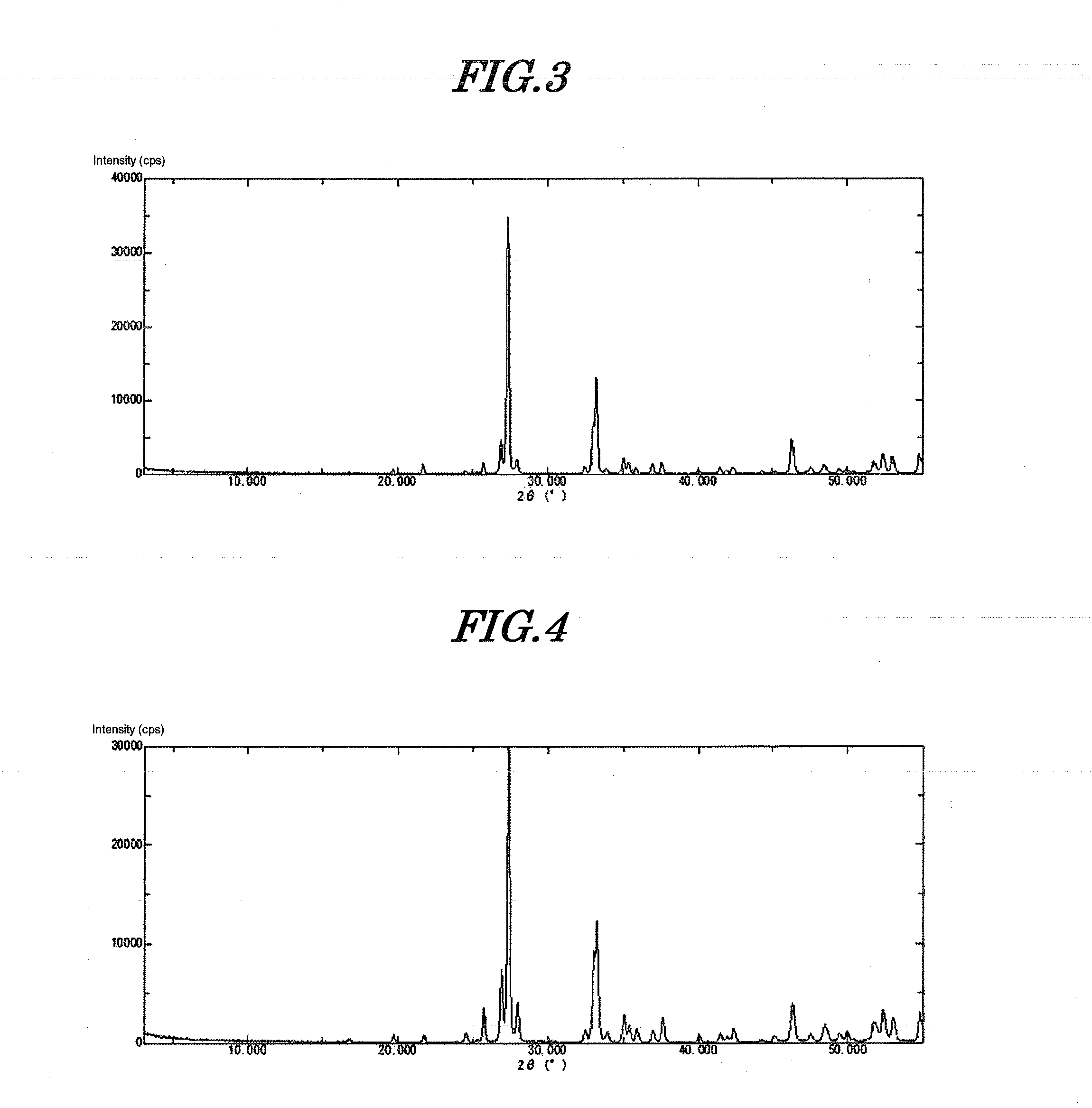Amorphous inorganic anion exchanger, resin composition for electronic component sealing, and process for producing amorphous bismuth compound
- Summary
- Abstract
- Description
- Claims
- Application Information
AI Technical Summary
Benefits of technology
Problems solved by technology
Method used
Image
Examples
example 1
[0099]530 g of a 5% aqueous solution of sodium hydroxide was cooled to 5° C. Furthermore, 60 g of a 50% aqueous solution of bismuth nitrate was diluted with 200 g of 5% nitric acid, and cooled to 5° C.
[0100]The aqueous solution of sodium hydroxide prepared was placed in a 1 L beaker and stirred at 400 rpm while cooling at 5° C. (pH=14). The entire amount of the cooled bismuth aqueous solution was added thereto within 1 minute using a funnel. The pH of the slurry after the dropwise addition was 13.0.
[0101]The precipitate thus obtained was immediately filtered, and the precipitate was washed with deionized water at 10° C. until the conductivity of the filtrate became no greater than 50 μS / cm. Filtration and washing were completed in 30 minutes. This precipitate was dried at 120° C. for 24 hours. Subsequently it was ground using a Fritsch Rotor-Speed Mill to give amorphous inorganic anion exchanger (amorphous bismuth compound) 1. This compound was subjected to ICP analysis, thus determ...
example 2
[0108]530 g of a 10% aqueous solution of sodium hydroxide was cooled to 5° C. Furthermore, 180 g of a 50% aqueous solution of bismuth nitrate was diluted with 420 g of 5% nitric acid. 2.8 g of tartaric acid was added thereto, dissolved, and cooled to 5° C. The aqueous solution of sodium hydroxide prepared was placed in a 2 L beaker and stirred at 400 rpm while cooling at 5° C. (pH=14). The entire amount of the cooled bismuth aqueous solution was added thereto within 1 minute using a funnel. The pH of the slurry after the dropwise addition was 13.2. The precipitate thus obtained was immediately filtered and washed with deionized water at 10° C. until the conductivity of the filtrate became no greater than 50 μS / cm. Filtration and washing were completed in 30 minutes. This precipitate was dried at 120° C. for 24 hours. Subsequently, it was ground to give amorphous inorganic anion exchanger (amorphous bismuth compound) 2. When this compound was analyzed, it was found to be BiO(OH), and...
example 3
[0110]530 g of a 10% aqueous solution of sodium hydroxide was cooled to 10° C. Furthermore, 180 g of a 50% aqueous solution of bismuth nitrate was diluted with 420 g of 5% nitric acid. 2.8 g of tartaric acid was added thereto, dissolved, and cooled to 10° C. The aqueous solution of sodium hydroxide prepared was placed in a 2 L beaker and it was stirred at 400 rpm while cooling at 10° C. (pH=14). The entire amount of the cooled bismuth aqueous solution was added thereto within 1 minute using a funnel. The pH of the slurry after the dropwise addition was 13.2. The precipitate thus obtained was immediately filtered and washed with deionized water at 10° C. until the conductivity of the filtrate became no greater than 50 μS / cm. Filtration and washing were completed in 30 minutes. This precipitate was dried at 120° C. for 24 hours. Subsequently, it was ground to give amorphous inorganic anion exchanger (amorphous bismuth compound) 3. When this compound was analyzed, it was found to be Bi...
PUM
| Property | Measurement | Unit |
|---|---|---|
| Temperature | aaaaa | aaaaa |
| Temperature | aaaaa | aaaaa |
| Temperature | aaaaa | aaaaa |
Abstract
Description
Claims
Application Information
 Login to View More
Login to View More - R&D
- Intellectual Property
- Life Sciences
- Materials
- Tech Scout
- Unparalleled Data Quality
- Higher Quality Content
- 60% Fewer Hallucinations
Browse by: Latest US Patents, China's latest patents, Technical Efficacy Thesaurus, Application Domain, Technology Topic, Popular Technical Reports.
© 2025 PatSnap. All rights reserved.Legal|Privacy policy|Modern Slavery Act Transparency Statement|Sitemap|About US| Contact US: help@patsnap.com



